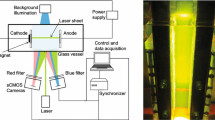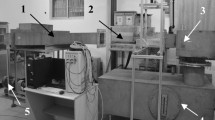Abstract
The effect of electrogenerated gas bubbles with simultaneous bulk liquid flow on the mass and momentum transfer at a wall of an electrolytic cell is experimentally determined. The local mass transfer coefficient and electrolyte shear stress are obtained using two types of microelectrodes imbedded in the channel wall. The influence of the most important parameters (electrolyte velocity, position along the wall, gas electrogeneration rate) on the transfer enhancement is studied and an analogy between mass and momentum transfer in the presence of bubbles is clearly demonstrated from the experimental results. The comparison with classical correlations, valid for systems involving natural turbulence, shows the higher energetic efficiency of devices where the turbulence is artificially generated by electrolytic gas bubbles.
Similar content being viewed by others
Abbreviations
- A :
-
constant parameter in Equation 3
- ¯C :
-
time averaged value of the concentration of a reacting species
- c 0 :
-
molar concentration in the bulk of the solution
- d :
-
microelectrode diameter
- d e :
-
hydraulic equivalent diameter
- D :
-
molecular diffusion coefficient
- D t :
-
turbulent diffusivity of mass transfer
- f/2:
-
friction factor, =τ/gr¯v 2
- h :
-
channel thickness
- I g :
-
electrogeneration rate
- i g :
-
electrogeneration current density
- i l :
-
limiting current density on a microelectrode imbedded in the conducting wall
- i′l :
-
limiting current density on a microelectrode imbedded in the inert wall
- k d :
-
local mass transfer coefficient
- k′ :
-
local mass transfer coefficient on a microelectrode in the non-conducting wall
- N M :
-
specific mass flux near an interface
- Re :
-
Reynolds number, = (¯vd e)/v
- s :
-
velocity gradient, = (∂¯v x/∂y)y = o
- s + :
-
dimensionless velocity gradient, =sd 2/D
- Sc :
-
Schmidt number, =v/D
- Sh :
-
Sherwood number, = (k d x)/D
- St :
-
Stanton number, =k d/¯v
- ¯v, ¯v x :
-
electrolyte velocity
- v * :
-
friction velocity, = (τ/ρ)1/2
- v + :
-
normalized velocity, =¯v x /v *
- x :
-
axial coordinate
- y :
-
coordinate perpendicular to the wall
- y + :
-
dimensionless length = (yv *)/v
- α:
-
parameter defined in Equation 8
- δ:
-
boundary layer thickness
- δ+ :
-
dimensionless form of δ, = δ(s/v)1/2
- τ, τx :
-
electrolyte shear stress
- μ :
-
dynamic viscosity
- ν :
-
kinematic viscosity
- ν t :
-
momentum transfer diffusivity
- ρ :
-
specific gravity
- σ2 :
-
variance of the fluctuations ofi L ori′ L
References
Gh. Barthole, A. Storck, A. Laurent and J. C. Charpentier,Int. Eng. Chem., Process Des. Dev. 19 (1980) 514.
Idem, Entropie 93 (1980) 30.
Idem, Int. Chem. Eng. 22 (1982) 244.
N. Ibl and J. Venczel,Metalloberfläche 24 (1970) 365.
I. Rousar and V. Cezner,Electrochim. Acta 20 (1975) 289.
K. Stephan and H. Vogt,ibid. 24 (1979) 11.
L. J. J. Janssen and J. G. Hoogland,ibid. 18 (1973) 543.
L. J. J. Janssen,ibid. 23 (1978) 81.
Idem, ibid. 24 (1979) 693.
A. Storck, Thesis, Nancy (1976).
A. Storck and F. Coeuret,Electrochim. Acta,22 (1977) 1155.
A. Storck and D. Hutin,ibid. 26 (1981) 127.
M. G. Fouad and G. H. Sedahmed,ibid. 17 (1972) 665.
C. I. Elsner and S. L. Marchiano,J. Appl. Electrochem. 12 (1982) 735.
G. Cognet, M. Lebouche and M. Souhar,AIChE J. 30 (1984) 338.
L. Rosenhead, ‘Laminar Boundary Layers’, Oxford University Press, Oxford (1963).
D. J. Pickett, ‘Electrochemical Reactor Design’, Elsevier, New York (1977) Chap. 4, pp. 125–134.
N. Ibl, in ‘Comprehensive Treatise of Electrochemistry’, Vol. 6, Plenum Press, New York (1983) Chap. 3.
F. Coeuret and A. Storck, ‘Eléments de Génie Electrochimique’, Technique et Documentation, Lavoisier, Paris (1984).
D. T. Wasan and C. R. Wilke,Int. J. Heat Mass Transfer 7 (1964)87.
E. R. G. Eckeit and J. F. Gross, ‘Introduction to Heat and Mass Transfer’ McGraw Hill, New York (1963).
C. S. Lin, E. B. Denton, H. L. Gaskill and G. L. Putnam,Ind. Eng. Chem. 43 (1951) 2136.
O. C. Sandall, O. T. Hanna and P. R. Mazet,Can. J. Chem. Eng. 58 (1980) 443.
R. G. Deissler, NACA Report 1210 (1955).
Author information
Authors and Affiliations
Rights and permissions
About this article
Cite this article
Giron, F., Valentin, G., Lebouche, M. et al. Mass and momentum transfer enhancement due to electrogenerated gas bubbles. J Appl Electrochem 15, 557–566 (1985). https://doi.org/10.1007/BF01059297
Received:
Issue Date:
DOI: https://doi.org/10.1007/BF01059297




